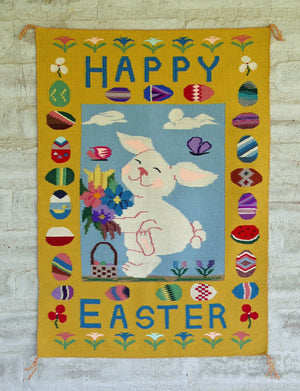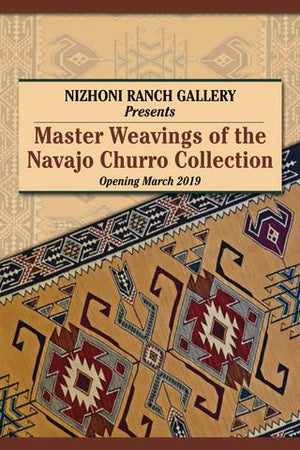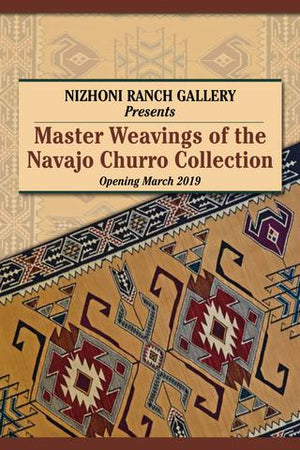Nizhoni Ranch News

Heard Hits It Out of the Park!
Color Riot! How Color Changed Navajo Textiles
Through September 3, 2019
Color Riot! How Color Changed
Navajo weavers’ individualism and flair for experimentation is vividly expressed in textiles from the last quarter of the 19th century. The textiles are rooted in ideas and events the weavers experienced between 1863 and 1868, the hard years of their imprisonment in the Bosque Redondo, and their subsequent return to a reservation. During this time, weavers saw examples of the design system of Hispanic textiles and acquired new materials such as aniline dyes and Germantown yarns that touched off their experiments with color and design. Commercial products at trading posts sparked additional design ideas for weavers. This was a time when outside market influences were at a low point. The old indigenous trading networks had been disrupted, woven garments were being replaced with commercial cloth and traders had not yet developed design constraints of the rug market that developed in the early 1900s. During this time of great change, as the Navajo rebuilt their flocks and repaired the devastation of Bosque Redondo, weavers had an unprecedented freedom to experiment.
Change has always been a hallmark of Navajo textile design, with the weavers’ individualism to a greater or lesser degree a continuing theme. Today, Navajo textiles are viewed as art with the singular vision of the weaver appreciated and applauded just as the vision of an artist working in the Euro-American artistic tradition has always been recognized.
Click here to view our weavings that are part of this show
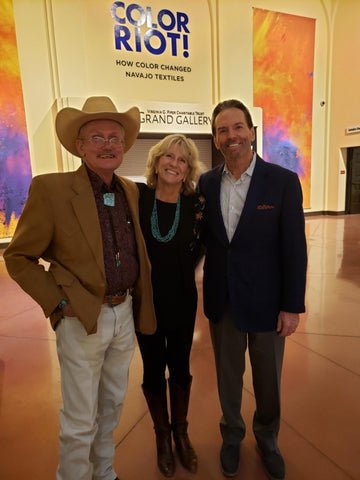
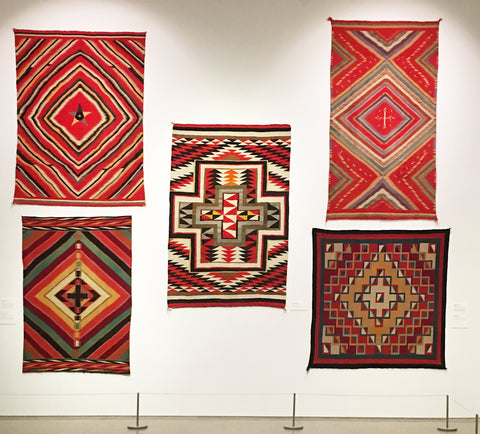


Manta Serape
Circa: 1860-1865
57" x 75.5"
PC 258
Call for Pricing
520-455-5020
Navajo Twill Double Saddle Blanket
Circa: 1890's - 1900
35" x 53"
Call for Pricing
520-455-5020
SOLD!

Pictorial - Great Star - Germantown Yarn
Circa: 1880's
62" x 83"
SOLD

Transitional Optical
Circa: 1890
61" x 87"
Call for Pricing
520-455-5020
SOLD!

Double Saddle Blanket
Circa: 1880-1890
28" x 48"
Call for Pricing
520-455-5020

Serape - Rio Grande Saltillo Style
Circa: early 1880's
PC 35
Call for Pricing
520-455-5020

3rd Phase Chief Blanket
Circa: 1880's
56" x 78"
PC 278
Call for Pricing
520-455-5020

Transitional
Circa: 1880 - 1890's
61" x 89"
GHT 2150
Call for Pricing
520-455-5020

Saxony Blanket
Circa: 1875
52" x 77"
PC 254
SOLD!
- Beth Barth

Congratulations to Dos Cabezas Wineworks!
Dos Cabezas Wineworks, one Sonoita's local wineries has won "Best of Show", "Best Red Wine" & "Best Non-Traditional Red Blend" for their 2015 Aguileon in the 2018 azcentral.com Arizona Wine Competition!
Quite an honor, but frankly we are not surprised. The small family run winery headed by Todd and Kelly Bostock have been making award winning wines for more than a decade. Their 2015 Aguileon scored 93 points - JamesSuckling.Com.
Their tasting room is casual and welcoming. A great way to start a day of wine tasting - or start of a wine tasting weekend! In addition to fantastic wine, Todd and Kelly offer accommodations conveniently located next door to their wine tasting room at 3248 Hwy 82, Sonoita AZ.
Make it a weekend of weavings and wine. Both Nizhoni Ranch Gallery and Dos Cabezas Wineworks are located in the heart of the Sonoita Wine Country, just 45 minutes South East of Tucson.
Todd and Kelly Bostock of Dos Cabezas Wineworks in the high desert in Sonoita, Arizona. (Photo by Pat Shannahan)
- Beth Barth

Opening Reception for "Master Weavings of the Navajo Churro Collection"
You are cordially invited to our special opening reception in celebration of our upcoming exhibit "Master Weavings of the Navajo Churro Collection".
When: Saturday March 9th, 12:00 pm to 3:00 pm
Where: Nizhoni Ranch Gallery, 51 E Pinto Trail, Sonoita AZ
Reception event will include a walk and talk with Steve and opportunity to watch Master Navajo Weaver Elsie Bia working on her latest rug!
Please join us! RSVP by March 7th: 520-455-5020
- Beth Barth
Have You Heard?
We are thrilled to announce The Heard Museum has asked us to participate
in an upcoming exhibit tentatively opening April 1, 2019!
Combing through the entire collection and the deepest darkest vaults, we pulled some of our most dramatic and rare pieces that have not seen the light of day for many moons. The Heard asked us to focus on the most visually brilliant and mystifying weavings. We think we nailed it. We can't wait for the opening and will keep everyone in the loop!
- Beth Barth

Navajo Churro Wool Rugs and Blankets - The Getzwiller Churro Collection
Master Weaver Elsie Bia has created yet another special weaving! This Ganado with Hero Twins is made with Churro wool. Winner of a Blue ribbon at the 2018 Gallup Inter -Tribal Ceremonial.
In the 1990s the quality and uniqueness of Navajo weavings was on the decline. Steve met with an old friend, Ray Dewey, in Santa Fe and they discussed how the quality of Navajo weavings could be improved. The answer was improve the quality of the wool and dyes.
For hundreds of years Churro sheep have been the center of Navajo life. Navajo churro wool was the first weaving wool of the Navajo Nation because of its low lanolin content, long staple and translucent qualities. Unfortunately the churro sheep were nearly exterminated by outside forces.
In the Getzwiller Historic Textile (GHT) collection exists beautiful pieces that are 100 years old, woven with Churro wool. Which confirms churro wool is the best and only becomes better with time. This conclusion planted the seed to bring Navajo churro wool back to the loom.
Steve was able to find the source of the Navajo Churro Registry where the genetics were being perfected for a better fleece.
Next, Steve found dye artists to dye the wool by hand for what would later be called the 'Navajo Churro Collection'. Though it seems like a simple thing, this took several years to put together. The final step was finding the best weavers on the Nation who were willing to use the Churro wool. The weavers were thrilled with the wool and loved the new colors (Indigo, Cochineal and the highest quality dyes from Switzerland). With that, the Navajo Churro Collection was born.
The Navajo Churro Collection celebrates the Navajo weavers and the art of the loom. The Nizhoni Ranch Gallery exclusively offers these weavings to the world, which represent some of the finest Navajo weavings ever made. As it is a legacy well worth preserving.
 Churro # 1416, Elsie Bia, Teec Nos Pos / Storm Pattern
Churro # 1416, Elsie Bia, Teec Nos Pos / Storm Pattern
1st place AND Best of Category awards!
2015 Gallup Inter-Tribal Ceremonial

Churro # 1574, Geraldine Phillips, Teec Nos Pos
1st place Best of Category
2018 Gallup Inter-Tribal Ceremonial
2016 Gallup Inter-Tribal Ceremonial
Joe Ben Wheat Award is given for exceptional Design
2013 Gallup Inter-Tribal Ceremonial
- Beth Barth

Natural Dyes - Old Traditions Dye Hard, for that we thank you!
Natural Beauties
 Indigofera Tinctoria
Indigofera Tinctoria
On to Cochineal dye. Cochineal dye has and interesting history. It starts with a tiny insect named Cochineal and the Prickly Pear Cactus. The insect lives on the pads of the cactus. The insects are brushed from the cactus, sun dried and ground into a dye powder. The dye creates beautiful deep scarlet, red and purple hues. During the Aztec Empire, Cochineal became Mexico's second-most valued export, second only to silver. When the Spanish arrived in 1519 they were impressed and intrigued with the Aztec's use brightly colored clothes.
 Prickly Pear Cactus infested with Cochineal,
Prickly Pear Cactus infested with Cochineal, (Photo credit: Tucson Cactus and Succulent Society)

Cochineal dyed wool

In the late 1700s the Navajo were at war with neighboring tribes and the Spanish Colonist in the Rio Grand Valley. Spain dispatched a punitive expedition to the Navajo stronghold of Canyon De Chelly. This punitive expedition was sent to punish the Navajo in the worst way.


1st Phase Chief Blanket, Churro # 1569
Navajo weaver Judy Marianito just finished (2018) this unique 1st Phase Chief Blanket. It is woven like a classic Chief Blanket, it has the handle of a true blanket weave. Narrow Cochineal red and Indigo blue stripes are highlighted with a thick black band. The ivory banding adds to the over all effect. Truly special.
- Beth Barth

An Organic Experience
Excerpt from The Fine Art of Navajo Weaving, text by Steve Getzwiller, photos by Ray Manley
This incredible piece of art is featured at the Desert Caballeros Western Museum as part of the exhibit, "One Traders Legacy, Steve Getzwiller Collects the West"
Weavers are still weaving gorgeous Burntwater rugs today. Some still go to the extra mile and make their own dyes using native reservation plants and other natural materials. Using vegetal dyes, also known as natural dyes, plays a major role in the quality and value of Burntwater rugs. In fact, weaving a rug with hand dyed natural wool can double the amount of time it takes to complete a weaving. Therefore, weavings made with natural dyes are of much higher value. Important to note, when purchasing a Burntwater rug, be sure to identify if the weaver used vegetal dyes versus analine (commercial) dyes as it greatly impacts the value of the weaving.
Elvie Van Winkle, one of our contemporary weavers, is known for her very tight Navajo weavings, but this weaving was a whole new adventure for her. As she wove this rug, she also hand dyed the wool with natural dyes to create the most incredible colors and color combinations. She learned this regional style and family secret dye colors from Lillian Joe, her mom, who continues to weave today. Lillian is well known for weaving with fine wool, and usually produces small weavings.
This weaving is 3' x 4' and showcases Elvie's incredible talent. It is everything that a Burntwater should be, colorful, balanced and intricate! Elvie told us she used 60 different wool colors and except for just a few were all hand dyed with vegatal dyes!!!
Elvie won 1st Place and Best of Category at the 2018 Gallup Inter-Tribal Ceremonial in August for this incredible weaving. Sorry, it's no longer available! 
Below is Elvie's latest work of art. She is so talented! Not sure if this one will last until August..so that we can enter it into the 2019 Gallup Inter-tribal Indian Ceremonial. No ribbon or not this is truly spectacular weaving!
BURNTWATER NAVAJO WEAVING : ELVIE VAN WINKLE : 3373
As always, we'd love to talk about our weavings! Give us a call! 520-455-5020
- Beth Barth

News Flash! Third Encore! Desert Caballeros Western Museum Exhibit
We Are Thrilled! Held Over for a Third Run!
The Desert Caballeros Western Museum in Wickenburg, has asked to extend our exhibit “One Trader’s Legacy: Steve Getzwiller Collects the West”. through September 2019! (the media release reflects through May of 2019, but since going to print DCWM has asked for it to stay through September 2019!)

Below is the great article Susan Sorg wrote about our first hold over!
Encore! Encore! Encore!
By Susan Sorg
When a rock star or performing artist exceeds the audience’s expectations, there’s usually an extra number, an extra song or bow given…an encore performance. But in the museum world, what would the encore for a special exhibit be? How about an extended stay? That’s exactly what’s going on at the Desert Caballeros Western Museum in Wickenburg, with “One Trader’s Legacy: Steve Getzwiller Collects the West”.
This stunning collection of art, artifacts and historical pieces opened to the public in November 2017 and was scheduled to close June 3rd. Approximately 20,000 museum attendees have seen it so far. However, if you haven’t yet, you now have until October 28th to take it all in. It’s a move unprecedented by the museum. “It’s an extraordinary step for us, but it’s by popular demand,” says museum Executive Director Daniel Finley. “People just seem to not get enough of it, so we’re very happy to accommodate.”
Getzwiller, who has his own venue, Nizhoni Ranch Gallery in Sonoita, has also exhibited in other galleries and museums throughout the West over the years. He says this extension is a first for him as well. “This is the fifth show that I’ve done with Desert Caballeros,” he says. “I consider it an honor.”
Steve Getzwiller, long considered a premier expert, collector and dealer in Navajo textiles has not only helped to preserve this particular art form, but raised it to a new level as he’s expanded the horizons and materials of several master weavers. Besides using the traditional churro wool, they’ll also now use silk or alpaca when creating special “wearable art” as he calls some of the ponchos and blankets also on display here.
For the past 50 years, he’s been working with and gaining the trust of generations of weavers within the Navajo Nation. Steve and his wife Gail have become extended family to some of these artisans. But, he’s also become acquainted with and doing business with other Native American artists in pottery, basketry, jewelry and other art forms as well as quietly collecting for himself some outstanding and historical pieces. Many of these now fill the display cases at the Wickenburg museum with several magnificent and award-winning rugs hanging from the rafters.
Getzwiller is the real deal when it comes to being an authentic cowboy and rancher. His western roots run deep in southeastern Arizona, even stretching as far back as the founding of the Republic of Texas. This is reflected in one of the displays at Desert Caballeros. “The Family” case includes old branding irons used by generations of Getzwillers along with ropes and spurs which once belonged to his dad, a rodeo contender on the national level in the 1940s, 50s and 60s. Behind it all hangs a Navajo weaving depicting a cowhide with the various family brands incorporated. This is the first time the public is getting a truly personal glimpse into the very private life of Getzwiller.
There’s also historic Navajo weavings, true one-of-a-kind pieces dating back to the mid-1800s which you won’t find anywhere else, along with antique Navajo saddles and silver headstalls. The same is true of Hopi pottery with the works of generations of the Nampeyo family dating back to the early 1900s. Other displays have Apache items made during the days of Geronimo. Then there’s the display of western firearms, including the pearl-handled pistol of a Tucson lawman.
Basketry plays a major role, as well, with the very best of Hopi, Apache, Pima, and several California and Pacific Northwest tribes. You’ll see Hopi kachinas crafted by Lowell Talashoma and paintings by Navajo and Hopi artists near paintings by western artist Jack Van Ryder. Then there’s several magnificent orotones from the early 1900s done by Edward S. Curtis, as he captured the end of an era in Native American history.
Museum Executive Director Daniel Finley says it’s the depth of Getzwiller’s collection which really draws people in. “First off the overall reaction is that it’s tremendous. Steve and Gail have the best collection of the Navajo blankets and other artifacts that there is. Steve’s the best collector in the world of these things…Just the best there is.”
Getzwiller says he’s a collector first, so when he came across many of these special items, it was an opportunity he just could not pass up. He’s already hard at work on an upcoming show in Santa Fe in August, before, during and after the annual world renowned Indian Market. The pieces currently in Wickenburg, though, will remain through October 28th, with another 5,000 people anticipated to go through the museum. That’s good news for those planning a visit to Desert Caballeros, and certainly pleasing to Executive Director Finley.
“I can tell you that people are certainly excited to see it for the first time, and are encouraging others to come. No question about that.”
Wickenburg...Historic Wonder of the West
Want an authentic taste of the wild west? Wickenburg is the real deal. The town has successfully merged the past with the present in a way that awakens the cowboy in everyone!
- Beth Barth



















 Churro # 679, Helene Nez, Sand Painting
Churro # 679, Helene Nez, Sand Painting








